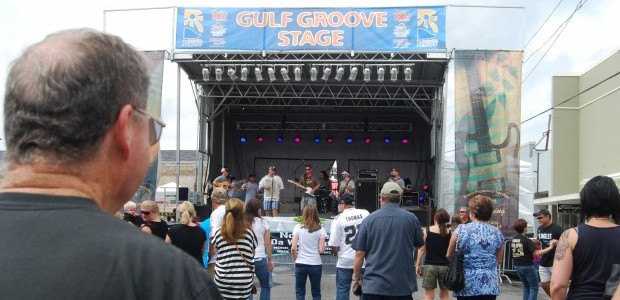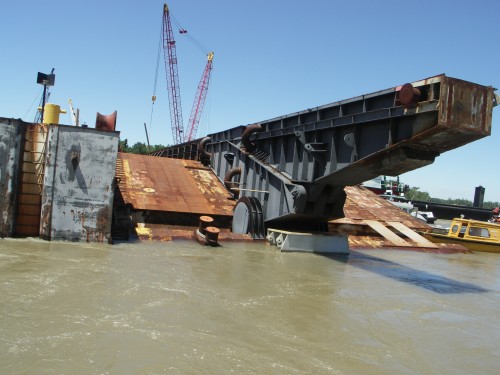
Rain plagues weekend festival
October 2, 2012
State supt: Schools need to be business ready
October 2, 2012Tri-parish leaders have preached a message of locals taking action to get projects accomplished. Their efforts are beginning to pay off. This was demonstrated Friday when the U.S. Department of Commerce Economic Development Administration approved funds to help finance the design of a permanent flood control structure in Bayou Chene.
During spring flooding in May and June 2011, the St. Mary Parish Levee District took the lead to position a temporary barge on the approximate border of St. Mary and Terrebonne parishes. Afterward, backwater and tidal surge control along this link between the Atchafalaya River and Intracoastal Waterway became a priority.
“We qualified for about $1.8 million in grant money for engineering designs, technical designs and surveys,” St. Mary Parish Levee District Executive Director Hilary Thibodeaux said. “This is for us to get it shovel ready.”
Design efforts will be shared among local engineers and construction professionals with Shaw Coastal, T. Baker Smith and Miller Engineering.
Construction cost estimates for a permanent barge floodgate facility range from $50-to-$80 million. The barge floodgate is expected to be positioned close to where a temporary structure had been located, nearly one mile into Terrebonne Parish.
Placement of the permanent flood control system is a cooperative effort between the St. Mary and Terrebonne parish levee districts in concert with the South Central Planning and Development Corporation and local governments.
“This $1.8 million will go toward the $5 million design cost,” Terrebonne Levee and Conservation Executive Director Reggie Dupre said. “I don’t want Terrebonne to overshadow the St. Mary Levee District. They took the lead in this.”
Dupre said for Terrebonne Parish this project means that existing levee structures along Bayou Black and Gibson will now be able to serve as backup systems. “The main threat of flooding from western Terrebonne in that area comes from Bayou Chene,” he said. “Having a structure in Bayou Chene serves the purpose of both backwater river flooding as well as tidal surges for tropical systems.”
A target year to begin construction of the estimated 400-foot long flood control structure is 2015. As a size comparison, the Houma Navigational Canal floodgate is 250 feet in length. Dupre said that while a Bayou Chene gate would be wider, it would not be as high as HNC structure.
“The further inland you are, the height only has to be to a plus-10- feet elevation,” Dupre said. “The HNC at Dulac, it has to be 18 feet above sea level.”
U.S. Army Corps of Engineers Spokesman Ken Holder declined to address the Commerce Department decision. “I don’t think we would generally comment on another agency’s project,” he said.
State Rep. Bret Allain said he has already been in conversation with corps officials and was assured support of the Bayou Chene project. “That does not mean there won’t be mitigation, but it will be minimal,” he said.
Design is the first step toward full funding, according to Allain.
“I’m very excited about the first step being made and look forward to moving this project along,” he said. “This is a project not only important in St. Mary Parish, but deep into Terrebonne.”
“This is a step in the right direction,” Thibodeaux added. “Imagine, Morganza [to the Gulf in Terrebonne Parish] has not received any federal funds, so everybody has been lifting up their own bootstraps.”
“I think the big picture is that getting projects shovel ready has a benefit,” Dupre added. “Then you are able to take advantage of stimulus money. This will be a benefit for all of us in the region.”
Allain said federal funding for the Bayou Chene project in comparison to Morganza to the Gulf appears to be coming easier because the U.S. Army Corps of Engineers saw how much it cost for the completed temporary structure up-front. “They were very willing to give us an almost automatic permit to put it in, but I think what we have going for us here is that theory had already been proven and shown effective.”
Sixteen months ago assertive public demand heard from Franklin to Houma, combined with practical action, prompted the U.S. Army Corps of Engineers to quickly approve all permits for temporary flood control. The temporary barge structure was credited for saving Morgan City, Gibson and other areas from flooding.
Regional residents contend they secured the attention of federal agencies by being assertive.
“The Bayou Chene flood control project was created by locals out of local necessity,” Rep. Jeff Landry said in a printed statement. “This is a great example of how government should work: local ideas coming forward without being constrained by government red tape for the good of the people.”
A barge rests in Bayou Chene to protect St. Mary Parish during the flood threat of 2011. The U.S. Department of Commerce Economic Development approved approximately $1.8 million in grant funding toward making the flood-control system permanent.











